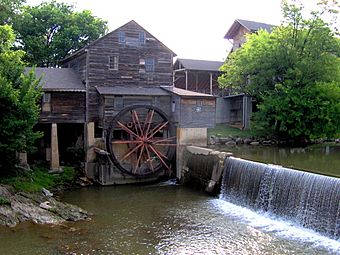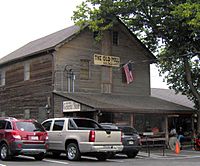Pigeon Forge Mill facts for kids
Quick facts for kids |
|
|
Pigeon Forge Mill
|
|

The Old Mill and milldam
|
|
| Location | Off U.S. Route 441 |
|---|---|
| Nearest city | Pigeon Forge, Tennessee |
| Area | Less than 1 acre (0.40 ha) |
| Built | 1830 |
| Architect | Isaac Love |
| NRHP reference No. | 75001778 |
| Added to NRHP | June 10, 1975 |
The Pigeon Forge Mill, also known as the Old Mill, is a very old and important building in Pigeon Forge, Tennessee. It's a special type of mill called a gristmill. This means it was used to grind grain, like corn and wheat, into flour.
The mill sits next to the West Fork of the Little Pigeon River. Today, it still has its millhouse, a large water wheel, and a milldam, all of which still work! The Old Mill is the only building in Pigeon Forge that is listed on the National Register of Historic Places. This means it's officially recognized as an important historical site.
Long ago, the Pigeon Forge Mill was part of a bigger industrial area. A businessman named Isaac Love built it in 1830. This area also had an iron forge, which is how the city of Pigeon Forge got its name. The mill helped local farmers by grinding their grains.
During the American Civil War (1861–1865), the mill helped make cloth for soldiers. Later, in the early 1900s, it even made electricity for the area until 1930. When the Great Smoky Mountains National Park opened nearby in 1934, Pigeon Forge became a popular place for visitors. The Old Mill then became a favorite stop for tourists. Today, it's a fun souvenir shop and restaurant.
Where is the Old Mill Located?
The Pigeon Forge Mill is on the east side of the West Fork of the Little Pigeon River. This river flows from the Great Smoky Mountains in the south. It goes through Gatlinburg and Pigeon Forge.
You can find the mill by taking Old Mill Avenue. This road connects to US 441 (also called Parkway, near Light #7) in the middle of Pigeon Forge. There's a small area of shops around the mill called the Old Mill Square.
The Mill's Long History
The land where the Pigeon Forge Mill stands was first given to Mordecai Lewis in 1810. He was a soldier from the American Revolutionary War. In 1817, Isaac Love, who was Mordecai's son-in-law, built an iron forge here. This forge was used to make iron.
Isaac Love got a lot of land, over 7,000 acres (2,800 ha), because of a state law. This law gave tax breaks for building iron works on land that wasn't good for farming. Love dug up iron ore from nearby hills. He used wagons pulled by oxen to bring the ore to the forge. The forge turned the ore into iron bars.
In 1830, Isaac Love and his sons built the large gristmill next to the iron forge. Farmers used this mill to grind their grain. Isaac Love's iron business wasn't making money, so he sold everything in 1841. On May 29, 1841, Isaac's son, William, opened a post office for the growing community. He named it "Pigeon Forge."
A man named Alexander Preston ran the iron works until 1849. Then, John Sevier Trotter bought the mill and the forge. By 1856, Trotter was making two tons of iron bars each year.
During the U.S. Civil War, John Trotter supported the Union side. He put looms in the mill to make uniforms for local Union soldiers. After the war, Trotter made the mill bigger. He added a large wooden water wheel and a sawmill to cut wood. Trotter's son, George, sold the iron forge in 1885, but he kept running the mill.
In December 1900, A.T. Householder bought the Pigeon Forge Mill. Soon after, a generator was put in. This generator provided electricity to houses across the river. The current milldam was finished in 1916. Over the years, the mill was updated many times to welcome the tourists traveling along US-441.
How the Mill is Built
The Pigeon Forge Mill is a three-story building. It's supported by very strong 14-foot (4.3 m) by 14-foot (4.3 m) yellow poplar logs. These logs sit on big pillars made of river rock, which are now strengthened with concrete. These strong pillars have helped the mill survive many big floods, like the ones in 1875 and 1920. These floods even washed away bridges at the mill site!
Inside the mill, the walls are made of hand-cut hemlock and oak wood. They are held together with hickory pegs. The outside walls are covered with yellow poplar boards. The floor is made of pine boards held with nails. The longer part on the north side of the mill was added later in the 1800s. This part was built to hold the mill's new sawmill.
The Pigeon Forge Mill uses its large 24-foot (7.3 m) breastshot water wheel, which you can see from the outside. It also uses smaller tub wheels inside. Water from the milldam flows to these wheels. The mill uses two very heavy, two-ton French burr millstones to grind the grain.



